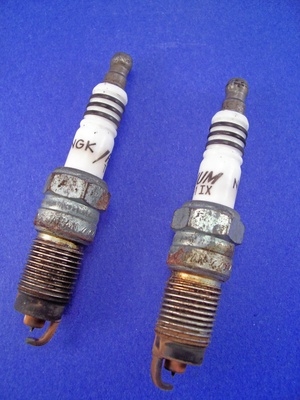
The spark plugs on the 2002 Ford Explorer enable combustion inside the vehicle's piston cylinder by providing a spark that ignites the fuel inside the cylinder. Once the fuel is ignited, it causes combustion, which in turn causes the pistons to rotate up and down and power the engine. Bad or weak spark plugs can cause the engine to misfire and will lead to increased fuel consumption.
Locate the air filter housing assembly on the passenger side of the engine. Remove the three bolts holding the air filter housing to the frame using a ratchet and a socket.
Loosen the lug nuts on both of the front tires using the lug wrench. (Do not remove the lug nuts.)
Jack up the front of the Ford Explorer and set the jack stands evenly under the front axles. Release the jack so that the front axle is sitting securely on the jack stands.
Remove both front tires with the lug wrench and set the tires to the side.
Remove the plastic cover between the engine and the tire on the passenger side using pliers and a flat head screwdriver. Once you remove the plastic cover, you will be able to see and access the spark plugs.
Pull the spark plug wire off the spark plug that is closest to the front of the engine first. Put the spark plug socket and the ratchet extension on the ratchet. Put the spark plug socket over the spark plug and turn the plug counterclockwise to loosen the plug. Once the plug is loosened, finish removing the spark plug by turning the spark plug with your fingers counterclockwise. Remove the spark plug from the hole.
Screw the new spark plug into the spark plug hole. Tighten the plug down with the ratchet. (Do not over-tighten.) Once the spark plug is tightened down, apply a little bit more pressure and the plug will be properly tightened into the spark plug hole. Reattach the spark plug wire to the spark plug. Push the spark plug wire onto the spark plug until it locks in place.
Keep removing and replacing the spark plugs on the passenger side following the same method. Remove the spark plug wire, remove the plug with the ratchet, unscrew the plugs with your hand, screw the new spark plug in place and tighten, and reattach the spark plug wire. When you are finished on the passenger side, reattach the plastic cover and move to the driver side of the engine.
Remove the plastic cover on the driver side between the engine and the tire with the pliers and screwdriver.
Remove the spark plug closest to the front of the engine. Replace one spark plug at a time with the ratchet, extension and spark plug socket. Follow the same method you used on the passenger side. Once you have finished installing the spark plugs, inspect everything to make sure that you put all the plug wires back onto the spark plugs.
Crank the engine to test the new spark plugs. The engine should be running smoothly.
Reattach the plastic cover on the driver side, put the driver side tire back on and tighten the tire down.
Put the passenger side tire back on and tighten it down. Jack the truck back up and remove the jack stands. Release the jack so that the truck returns to the ground.